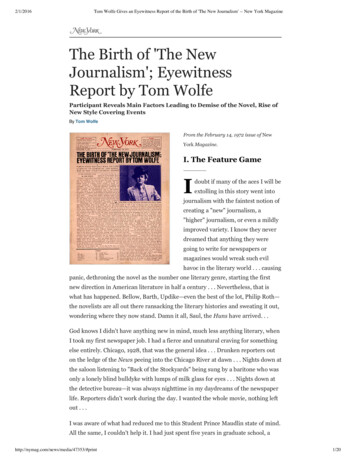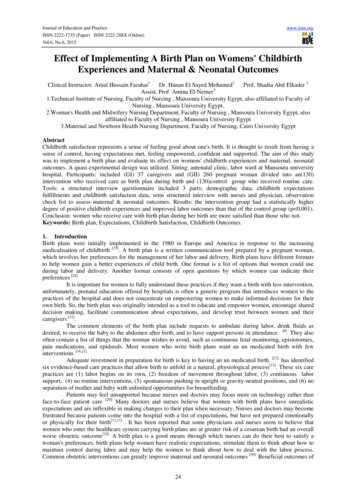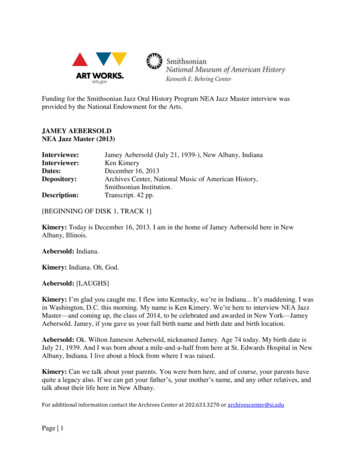
Transcription
2/1/2016Tom Wolfe Gives an Eyewitness Report of the Birth of 'The New Journalism' -- New York MagazineThe Birth of 'The NewJournalism'; EyewitnessReport by Tom WolfeParticipant Reveals Main Factors Leading to Demise of the Novel, Rise ofNew Style Covering EventsBy Tom WolfeFrom the February 14, 1972 issue of NewYork Magazine.I. The Feature GameIdoubt if many of the aces I will beextolling in this story went intojournalism with the faintest notion ofcreating a "new" journalism, a"higher" journalism, or even a mildlyimproved variety. I know they neverdreamed that anything they weregoing to write for newspapers ormagazines would wreak such evilhavoc in the literary world . . . causingpanic, dethroning the novel as the number one literary genre, starting the firstnew direction in American literature in half a century . . . Nevertheless, that iswhat has happened. Bellow, Barth, Updike—even the best of the lot, Philip Roth—the novelists are all out there ransacking the literary histories and sweating it out,wondering where they now stand. Damn it all, Saul, the Huns have arrived. . .God knows I didn't have anything new in mind, much less anything literary, whenI took my first newspaper job. I had a fierce and unnatural craving for somethingelse entirely. Chicago, 1928, that was the general idea . . . Drunken reporters outon the ledge of the News peeing into the Chicago River at dawn . . . Nights down atthe saloon listening to "Back of the Stockyards" being sung by a baritone who wasonly a lonely blind bulldyke with lumps of milk glass for eyes . . . Nights down atthe detective bureau—it was always nighttime in my daydreams of the newspaperlife. Reporters didn't work during the day. I wanted the whole movie, nothing leftout . . .I was aware of what had reduced me to this Student Prince Maudlin state of mind.All the same, I couldn't help it. I had just spent five years in graduate school, ahttp://nymag.com/news/media/47353/#print1/20
2/1/2016Tom Wolfe Gives an Eyewitness Report of the Birth of 'The New Journalism' -- New York Magazinestatement that may mean nothing to people who never served such a stretch; it isthe explanation, nonetheless. I'm not sure I can give you the remotest idea of whatgraduate school is like. Nobody ever has. Millions of Americans now go tograduate schools, but just say the phrase—"graduate school"—and what pictureleaps into the brain? No picture, not even a blur. Half the people I knew ingraduate school were going to write a novel about it. I thought about it myself. Noone ever wrote such a book, as far as I know. Everyone used to sniff the air. Howmorbid! How poisonous! Nothing else like it in the world! But the subject alwaysdefeated them. It defied literary exploitation. Such a novel would be a study offrustration, but a form of frustration so exquisite, so ineffable, nobody coulddescribe it. Try to imagine the worst part of the worst Antonioni movie you eversaw, or reading Mr. Sammler's Planet at one sitting, or just reading it, or beinglocked inside a Seaboard Railroad roomette, sixteen miles from Gainesville,Florida, heading north on the Miami to New York run, with no water and theradiator turning red in an amok psychotic over boil, and George McGovern sittingbeside you telling you his philosophy of government. That will give you thegeneral atmosphere.In any case, by the time I received my doctorate in American studies in 1957 I wasin the twisted grip of a disease of our times in which the sufferer experiences anoverwhelming urge to join the "real world." So I started working for newspapers.In 1962, after a cup of coffee here and there, I arrived at the New York HeraldTribune . . This must be the place! . . . I looked out across the city room of theHerald Tribune, 100 moldering yards south of Times Square, with a feeling ofamazed bohemian bliss . . . Either this is the real world, Tom, or there is no realworld . . . The place looked like the receiving bin at the Good Will . . . apromiscuous heap of junk . . . Wreckage and exhaustion everywhere . . . Ifsomebody such as the city editor had a swivel chair, the universal joint would bebroken, so that every time he got up, the seat would keel over as if stricken by alateral stroke. All the intestines of the building were left showing in diverticuliticloops and lines—electrical conduits, water pipes, steam pipes, effluvium ducts,sprinkler systems, all of it dangling and grunting from the ceiling, the walls, thecolumns. The whole mess, from top to bottom, was painted over in an industrialsludge, Lead Gray, Subway Green, or that unbelievable dead red, that grimdistemper of pigment and filth, that they paint the floor with in the tool and dieworks. On the ceiling were scalding banks of fluorescent lights, turning theatmosphere radium blue and burning bald spots in the crowns of the copyreaders, who never moved. It was one big pie factory . . . A Landlord's Dream . . .There were no interior walls. The corporate hierarchy was not marked off intooffice spaces. The managing editor worked in a space that was as miserable andscabid as the lowest reporter's. Most newspapers were like that. This setup wasinstituted decades ago for practical reasons. But it was kept alive by a curious fact.On newspapers very few editorial employees at the bottom—namely, the reporters—had any ambition whatsoever to move up, to become city editors, managingeditors, editors in chief, or any of the rest of it. Editors felt no threat from below.http://nymag.com/news/media/47353/#print2/20
2/1/2016Tom Wolfe Gives an Eyewitness Report of the Birth of 'The New Journalism' -- New York MagazineThey needed no walls. Reporters didn't want much . . . merely to be stars! and ofsuch minute wattage at that!That was one thing they never wrote about in books on journalism or thosecomradely blind bulldagger boots upon the brass rail swill bar speakeasymemoirs about newspaper days and children of the century . . . namely, the littlecurlicues of newspaper status competition . . . For example, at the desk behindmine in the Herald Tribune city room sat Charles Portis. Portis was the originallaconic cutup. At one point he was asked onto a kind of Meet the Press show withMalcolm X, and Malcolm X made the mistake of giving the reporters a littlelecture before they went on about how he didn't want to hear anybody calling him"Malcolm," because he was not a dining car waiter—his name happened to be"Malcolm X." By the end of the show Malcolm X was furious. He was climbing thegoddamned acoustical tiles. The original laconic cutup, Portis, had invariably andcontinually addressed him as "Mr. X" . . . "Now, Mr. X, let me ask you this . . ."Anyway, Portis had the desk behind mine. Down in a bullpen at the far end of theroom was Jimmy Breslin. Over to one side sat Dick Schaap. We were all engagedin a form of newspaper competition that I have never known anybody to even talkabout in public. Yet Schaap had quit as city editor of the New York HeraldTribune, which was one of the legendary jobs in journalism—moved down theorganizational chart, in other words—just to get in this secret game.Everybody knows about one form of competition among newspaper reporters, theso called scoop competition. Scoop reporters competed with their counterparts onother newspapers, or wire services, to see who could get a story first and write itfastest; the bigger the story—i.e., the more it had to do with matters of power orcatastrophe—the better. In short, they were concerned with the main business ofthe newspaper. But there was this other lot of reporters as well . . . They tended tobe what is known as "feature writers." What they had in common was that they allregarded the newspaper as a motel you checked into overnight on the road to thefinal triumph. The idea was to get a job on a newspaper, keep body and soultogether, pay the rent, get to know "the world," accumulate "experience," perhapswork some of the fat off your style—then, at some point, quit cold, say goodbye tojournalism, move into a shack somewhere, work night and day for six months, andlight up the sky with the final triumph. The final triumph was known as TheNovel.". . . Feature writers regarded newspapers as a motel stopon the road to final triumph . . ."That was Someday, you understand . . . Meanwhile, these dreamboaters were inthere banging away, in every place in America that had a newspaper, competingfor a tiny crown the rest of the world wasn't even aware of: Best Feature Writer inhttp://nymag.com/news/media/47353/#print3/20
2/1/2016Tom Wolfe Gives an Eyewitness Report of the Birth of 'The New Journalism' -- New York MagazineTown. The "feature" was the newspaper term for a story that fell outside thecategory of hard news. It included everything from "brights," chuckly little items,often from the police beat . . . There was this out of towner who checked into ahotel in San Francisco last night, bent upon suicide, and he threw himself out ofhis fifth story window—and fell nine feet and sprained his ankle. What he didn'tknow was—the hotel was on a steep hill! . . . to "human interest stories," long andoften hideously sentimental accounts of hitherto unknown souls beset by tragedyor unusual hobbies within the sheet's circulation area . . . In any case, featurestories gave a man a certain amount of room in which to write.Unlike the scoop reporters, the feature writers did not openly acknowledge theexistence of their competition, not even to one another. Nor was there any sort ofscorecard. And yet everyone in the game knew precisely what was going on andwent through the most mortifying sieges of envy, even resentment, or else surgesof euphoria, depending on how the game was going. No one would ever admit tosuch a thing, and yet all felt it, almost daily. The feature writers' arena differedfrom the scoop reporters' in another way. Your competition was not necessarilyworking for another publication. You were just as likely to be competing withpeople on your own paper, which meant you were even less likely to talk about it.So here was half the feature competition in New York, right in the same city roomwith me, because the Herald Tribune was like the main Tijuana bullring forfeature writers . . . Portis, Breslin, Schaap . . . Schaap and Breslin had columns,which gave them more freedom, but I figured I could take the both of them. Youhad to be brave. Over at the Times there was Gay Talese and Robert Lipsyte. Atthe Daily News there was Michael Mok. (There were other contenders, too, on allthe newspapers, including the Herald Tribune. I am only mentioning those Iremember most clearly.) Mok I had been up against before, when I worked on theWashington Post and he worked on the Washington Star. Mok was toughcompetition, because, for one thing, he was willing to risk his hide on a featurestory with the same wild courage he later showed in covering Vietnam and theArab Israel war for Life. Mok would do . . . eerie things. For example, the Newssends Mok and a photographer out to do a feature on a fat man who is trying tolose weight by marooning himself on a sailboat anchored out in Long IslandSound ("I'm one of those guys, I walk past a delicatessen and breathe deep, and Igain ten pounds"). The motorboat they hire conks out about a mile from the fatman's sloop, with only four or five hours to go before the deadline. This is March,but Mok dives in and starts swimming. The water is about 42 degrees. He swimsuntil he's half dead, and the fat man has to fish him out with an oar. So Mok getsthe story. He makes the deadline. There are pictures in the News of Mokswimming furiously through Long Island Sound in order to retrieve this greatblob's diet saga for two million readers If, instead, he had drowned, if he hadended up down with the oysters in the hepatitic muck of the Sound, nobody wouldhave put up a plaque for him. Editors save their tears for war correspondents. Asfor feature writers—the less said, the better. (Just the other day I saw one of thehttp://nymag.com/news/media/47353/#print4/20
2/1/2016Tom Wolfe Gives an Eyewitness Report of the Birth of 'The New Journalism' -- New York MagazineNew York Times's grand panjandrums react with amazement to superlative praisefor one of his paper's most popular writers, Israel Shenker, as follows: "But he's afeature writer!") No, if Mok had bought the oyster farm that afternoon, hewouldn't even have rated the quietest award in journalism, which is 30 seconds ofsilence at the Overseas Press Club dinner. Nevertheless, he dove into Long IslandSound in March! Such was the raging competition within our odd and tiny grotto!At the same time everybody in the game had terrible dark moments during whichhe lost heart and told himself: "You're only kidding yourself, boy. This is just onemore of your devious ways of postponing the decision to put it all on the line . . .and go into the shack . . . and write your novel." Your Novel! At this late date—partly due to the New Journalism itself—it is hard to explain what an Americandream the idea of writing a novel was in the 1940s, the 1950s, and right into theearly 1960s. The Novel was no mere literary form. It was a psychologicalphenomenon. It was a cortical fever. It belonged in the glossary to A GeneralIntroduction to Psychoanalysis, somewhere between Narcissism and ObsessionalNeuroses. In 1969 Seymour Krim wrote a strange confession for Playboy thatbegan: "I was literally made, shaped, whetted and given a world with a purpose bythe American realistic novel of the mid to late 1930s. From the age of fourteen toseventeen, I gorged myself with the works of Thomas Wolfe (beginning with OfTime and the River, catching up with Angel and then keeping pace till Big Tom'sstunning end), Ernest Hemingway, William Faulkner, James T. Farrell, JohnSteinbeck, John O'Hara, James Cain, Richard Wright, John Dos Passos, ErskineCaldwell, Jerome Weidman, and William Saroyan, and knew in my pumping heartthat I wanted to be such a novelist." The piece turned into a confession becausefirst Krim admitted that the idea of being a novelist had been the overwhelmingpassion of his life, his spiritual calling, in fact, the Pacemaker that kept his egoticking through all the miserable humiliations of his young manhood—then hefaced up to the fact that he was now in his forties and had never written a noveland more than likely never would. Personally I was fascinated by the article, butwhy Playboy was running it, I didn't know, unless it was the magazine's monthly10 cc. of literary penicillin . . . to hold down the gonococci and the spirochetes . . . Icouldn't imagine anyone other than writers being interested in Krim's Complex.That, however, was where I was wrong.After thinking it over, I realized that writers comprise but a fraction of theAmericans who have experienced Krim's peculiar obsession. Not so long ago, I amwilling to wager, half the people who went to work for publishing houses did sowith the belief that their real destiny was to be novelists. Among people on whatthey call the creative side of advertising, those who actually dream up the ads, thepercentage must have reached 90 per cent. In 1955, in The Exurbanites, the lateA. C. Spectorsky depicted the well paid Madison Avenue advertising genius asbeing a man who wouldn't read a novel without checking out the dust jacket blurband the picture of the author on the back . . . and if that ego flushed little 0
2/1/2016Tom Wolfe Gives an Eyewitness Report of the Birth of 'The New Journalism' -- New York Magazinewith the unbuttoned shirt and the wind rushing through his locks was youngerthan he was, he couldn't bear to open the goddamn book. Such was the grip of thedamnable Novel. Likewise among people in television, public relations, themovies, on the English faculties of colleges and high schools, among framing shopclerks, convicts, unmarried sons living with Mom . . . a whole swarm of fantasizersout there steaming and proliferating in the ego mulches of America . . .The Novel seemed like one of the last of those super strokes, like finding gold orstriking oil, through which an American could, overnight, in a flash, utterlytransform his destiny. There were plenty of examples to feed the fantasy. In the1930s all the novelists had seemed to be people who came blazing up into stardomfrom out of total obscurity. That seemed to be the nature of the beast. Thebiographical notes on the dustjackets of the novels were terrific. The author, youwould be assured, was previously employed as a hod carrier (Steinbeck), a truckdispatcher (Cain), a bellboy (Wright), a Western Union boy (Saroyan), adishwasher in a Greek restaurant in New York (Faulkner), a truck driver, logger,berry picker, spindle cleaner, crop duster, pilot . . . There was no end to it . . .Some novelists had whole strings of these credentials . . . That way you knew youwere getting the real goods . . .By the 1950s The Novel had become a nationwide tournament. There was amagical assumption that the end of World War II in 1945 was the dawn of a newgolden age of the American Novel, like the Hemingway Dos Passos Fitzgerald eraafter World War I. There was even a kind of Olympian club where the new goldenboys met face to face every Sunday afternoon in New York, namely, the WhiteHorse Tavern on Hudson Street . . . Ah! There's Jones! There's Mailer! There'sStyron! There's Baldwin! There's Willingham! In the flesh—right here in thisroom! The scene was strictly for novelists, people who were writing novels, andpeople who were paying court to The Novel. There was no room for a journalistunless he was there in the role of would be novelist or simple courtier of the great.There was no such thing as a literary journalist working for popular magazines ornewspapers. If a journalist aspired to literary status—then he had better have thesense and the courage to quit the popular press and try to get into the big league.As for our little league of feature writers—two of the contestants, Portis andBreslin, actually went on to live out the fantasy. They wrote their novels. Portis didit in a way that was so much like the way it happens in the dream, it wasunbelievable. One day he suddenly quit as London correspondent for the HeraldTribune. That was generally regarded as a very choice job in the newspaperbusiness. Portis quit cold one day; just like that, without a warning. He returnedto the United States and moved into a fishing shack in Arkansas. In six months hewrote a beautiful little novel called Norwood. Then he wrote True Grit, which wasa best seller. The reviews were terrific . . . He sold both books to the movies . . . Hemade a fortune . . . A fishing shack! In Arkansas! It was too goddamned perfect tohttp://nymag.com/news/media/47353/#print6/20
2/1/2016Tom Wolfe Gives an Eyewitness Report of the Birth of 'The New Journalism' -- New York Magazinebe true, and yet there it was. Which is to say that the old dream, The Novel, hasnever died.". . . At the same time everybody in the game had terribledark moments when he told himself: 'You're kiddingyourself, boy' . . ."And yet in the early 1960s a curious new notion, just hot enough to inflame theego, had begun to intrude into the tiny confines of the feature statusphere. It wasin the nature of a discovery. This discovery, modest at first, humble, in fact,deferential, you might say, was that it just might be possible to write journalismthat would . . . read like a novel. Like a novel, if you get the picture. This was thesincerest form of homage to The Novel and to those greats, the novelists, ofcourse. Not even the journalists who pioneered in this direction doubted for amoment that the novelist was the reigning literary artist, now and forever. All theywere asking for was the privilege of dressing up like him . . . until the day whenthey themselves would work up their nerve and go into the shack and try it for real. . . They were dreamers, all right, but one thing they never dreamed of. Theynever dreamed of the approaching irony. They never guessed for a minute that thework they would do over the next ten years, as journalists, would wipe out thenovel as literature's main event.II. Like a NovelWhat inna namea Christ is this—in the fall of 1962 I happened to pick upa copy of Esquire and read a story called "Joe Louis: the King as aMiddle aged Man." The piece didn't open like an ordinary magazine article at all.It opened with the tone and mood of a short story, with a rather intimate scene; orintimate by the standards of magazine journalism in 1962, in any case:" 'Hi, sweetheart!' Joe Louis called to his wife, spotting her waiting for him at theLos Angeles airport."She smiled, walked toward him, and was about to stretch up on her toes and kisshim—but suddenly stopped." 'Joe,' she said, 'where's your tie?'" 'Aw, sweetie,' he said, shrugging, 'I stayed out all night in New York and didn'thave time—'" 'All night!' she cut in. 'When you're out here all you do is sleep, sleep, sleep.'" 'Sweetie,' Joe Louis said, with a tired grin, 'I'm an ole man.'" 'Yes,' she agreed, 'but when you go to New York you try to be young again.' "http://nymag.com/news/media/47353/#print7/20
2/1/2016Tom Wolfe Gives an Eyewitness Report of the Birth of 'The New Journalism' -- New York MagazineThe story featured several scenes like that, showing the private life of a sportshero growing older, balder, sadder. It wound up with a scene in the home ofLouis's second wife, Rose Morgan. In this scene Rose Morgan is showing a film ofthe first Joe Louis Billy Conn fight to a roomful of people, including her presenthusband."Rose seemed excited at seeing Joe at the top of his form, and every time a Louispunch would jolt Conn, she'd go, 'Mummm' (sock). 'Mummm' (sock). 'Mummm.'"Billy Conn was impressive through the middle rounds, but as the screen flashedRound 13, somebody said, 'Here's where Conn's gonna make his mistake; he'sgonna try to slug it out with Joe Louis.' Rose's husband remained silent, sippinghis Scotch."When the Louis combinations began to land, Rose went, 'Mummmmm,mummmmm,' and then the pale body of Conn began to collapse against thecanvas."Billy Conn slowly began to rise. The referee counted over him. Conn had one legup, then two, then was standing—but the referee forced him back. It was too late."—and then, for the first time, from the back of the room, from out of the downybillows of the sofa, comes the voice of the present husband—this Joe Louis crapagain—" 'I thought Conn got up in time,' he said, 'but that referee wouldn't let him go on.'"Rose Morgan said nothing—just swallowed the rest of her drink."What the hell is going on? With a little reworking the whole article could haveread like a short story. The passages in between the scenes, the expositorypassages, were conventional 1950s style magazine journalism, but they could havebeen easily recast. The piece could have been turned into a non fiction short storywith very little effort. The really unique thing about it, however, was the reporting.This I frankly couldn't comprehend at first. I really didn't understand how anyonecould manage to do reporting on things like the personal by play between a manand his fourth wife at an airport and then follow it up with that amazing cakewalkdown Memory Lane in his second wife's living room. My instinctive, defensivereaction was that the man had piped it, as the saying went . . . winged it, made upthe dialogue . . . Christ, maybe he made up whole scenes, the unscrupulous geek . . The funny thing was, that was precisely the reaction that countless journalistsand literary intellectuals would have over the next nine years as the NewJournalism picked up momentum. The bastards are making it up! (I'm tellingyou, Ump, that's a spitball he's throwing . . .) Really stylish reporting wassomething no one knew how to deal with, since no one was used to thinking ofreporting as having an esthetic 8/20
2/1/2016Tom Wolfe Gives an Eyewitness Report of the Birth of 'The New Journalism' -- New York MagazineAt the time I hardly ever read magazines like Esquire. I wouldn't have read theJoe Louis piece except that it was by Gay Talese. After all, Talese was a reporterfor the Times. He was a player in my own feature game. What he had written forEsquire was so much better than what he was doing (or was allowed to do) for theTimes, I had to check out what was going on.". . . What the hell is going on? With a little reworkingTalese's whole article on Joe Louis could have read like ashort story . . ."Not long after that Jimmy Breslin started writing an extraordinary local columnfor my own paper, the Herald Tribune. Breslin came to the Herald Tribune in1963 from out of nowhere, which is to say he had written a hundred or so articlesfor magazines like True, Life, and Sports Illustrated. Naturally he was virtuallyunknown. At that time knocking your brains out as a free lance writer for popularmagazines was a guaranteed way to stay anonymous.* (See footnote.) Breslincaught the attention of the Herald Tribune's publisher, Jock Whitney, through hisbook about the New York Mets called Can't Anybody Here Play This Game? TheHerald Tribune hired Breslin to do a "bright" local column to help offset some ofthe heavy lumber on the editorial page, paralyzing snoremongers like WalterLippmann and Joseph Alsop. Newspaper columns had become a classicillustration of the theory that organizations tend to promote people up to theirlevels of incompetence. The usual practice was to give a man a column as a rewardfor outstanding service as a reporter. That way they could lose a good reporter andgain a bad writer. The archetypical newspaper columnist was Lippmann. For 35years Lippmann seemed to do nothing more than ingest the Times every morning,turn it over in his ponderous cud for a few days, and then methodically egest it inthe form of a drop of mush on the foreheads of several hundred thousand readersof other newspapers in the days thereafter. The only form of reporting that Iremember Lippmann going for was the occasional red carpet visit to a head ofstate, during which he had the opportunity of sitting on braided chairs inwainscotted offices and swallowing the exalted one's official lies in person insteadof reading them in the Times. I don't mean to single out Lippmann, however. Hewas only doing what was expected of him . . .In any case, Breslin made a revolutionary discovery. He made the discovery that itwas feasible for a columnist to leave the building, go outside and do reporting onhis own, actual legwork. Breslin would go up to the city editor and ask whatstories and assignments were coming up, choose one, go out, leave the building,cover the story as a reporter, and write about it in his column. If the story were bigenough, his column would start on page one instead of inside. As obvious as thissystem may sound, it was unheard of among newspaper columnists, whether localor national. If possible, local columnists are even more pathetic. They usually startout full of juice, sounding like terrific boulevardiers and raconteurs, retailing inhttp://nymag.com/news/media/47353/#print9/20
2/1/2016Tom Wolfe Gives an Eyewitness Report of the Birth of 'The New Journalism' -- New York Magazineprint all the marvelous mots and anecdotes they have been dribbling away overlunch for the past few years. After eight or ten weeks, however, they start to dryup. You can see the poor bastards floundering and gasping. They're dying of thirst.They're out of material. They start writing about funny things that happenedaround the house the other day, homey one liners that the Better Half or the Avonlady got off, or some fascinating book or article that started them thinking, or elsesomething they saw on the TV. Thank God for the TV! Without television shows tocannibalize, half of these people would be lost, utterly catatonic. Pretty soon youcan almost see it, the tubercular blue of the 23 inch screen, radiating from theirprose. Anytime you see a columnist trying to squeeze material out of his house,articles, books, or the television set, you've got a starving soul on your hands . . .You should send him a basket . . .*Richard Gehman once told me about running into Abe Rosenthal (nowmanaging editor of the "New York Times") shortly after Rosenthal had won thePulitzer Prize for his coverage of the Polish rebellion of 1960. Gehmancongratulated him profusely, whereupon Rosenthal, by way of being polite,asked Gehman if he were still writing for magazines. Gehman stared at him. Hewas dumbfounded. "Still writing?" At that moment he had sixteen articles onnewsstands, in magazines ranging from men's adventures to the "AtlanticMonthly."But Breslin worked like a Turk. He would be out all day covering a story, comeback in at 4 p.m. or so and sit down at a desk in the middle of the city room. It wasquite a show. He was a good looking Irishman with a lot of black hair and a greatwrestler's gut. When he sat down at his typewriter he hunched himself over into ashape like a bowling ball. He would start drinking coffee and smoking cigarettesuntil vapor started drifting off his body. He looked like a bowling ball fueled withliquid oxygen. Thus fired up, he would start typing. I've never seen a man whocould write so well against a daily deadline. I particularly remember one story hewrote about the sentencing, on a charge of extortion, of a Teamster boss namedAnthony Provenzano. Early in the story Breslin set up the image of the suncoming through the moldering old windows of the Federal courthouse andexploding off Provenzano's diamond pinky ring:"It did not seem like a bad morning at all. The boss, Tony Provenzano, who is oneof the biggest men in the Teamsters Union, walked up and down the corridoroutside of this Federal courtroom in Newark and he had a little smile on his faceand
New Style Covering Events By Tom Wolfe From the February 14, 1972 issue of New York Magazine. I. The Feature Game doubt if many of the aces I will be extolling in this story went into journalism with the faintest notion of creating a "new" journalism, a "higher" journalism, or even a mildly improved variety.











